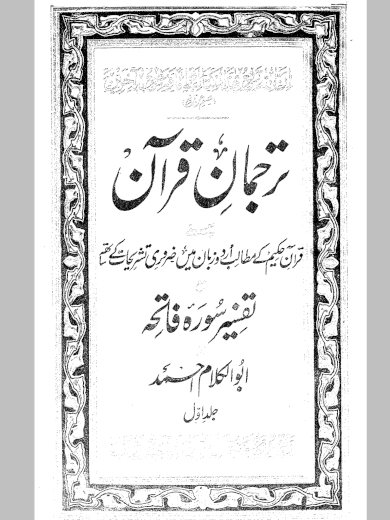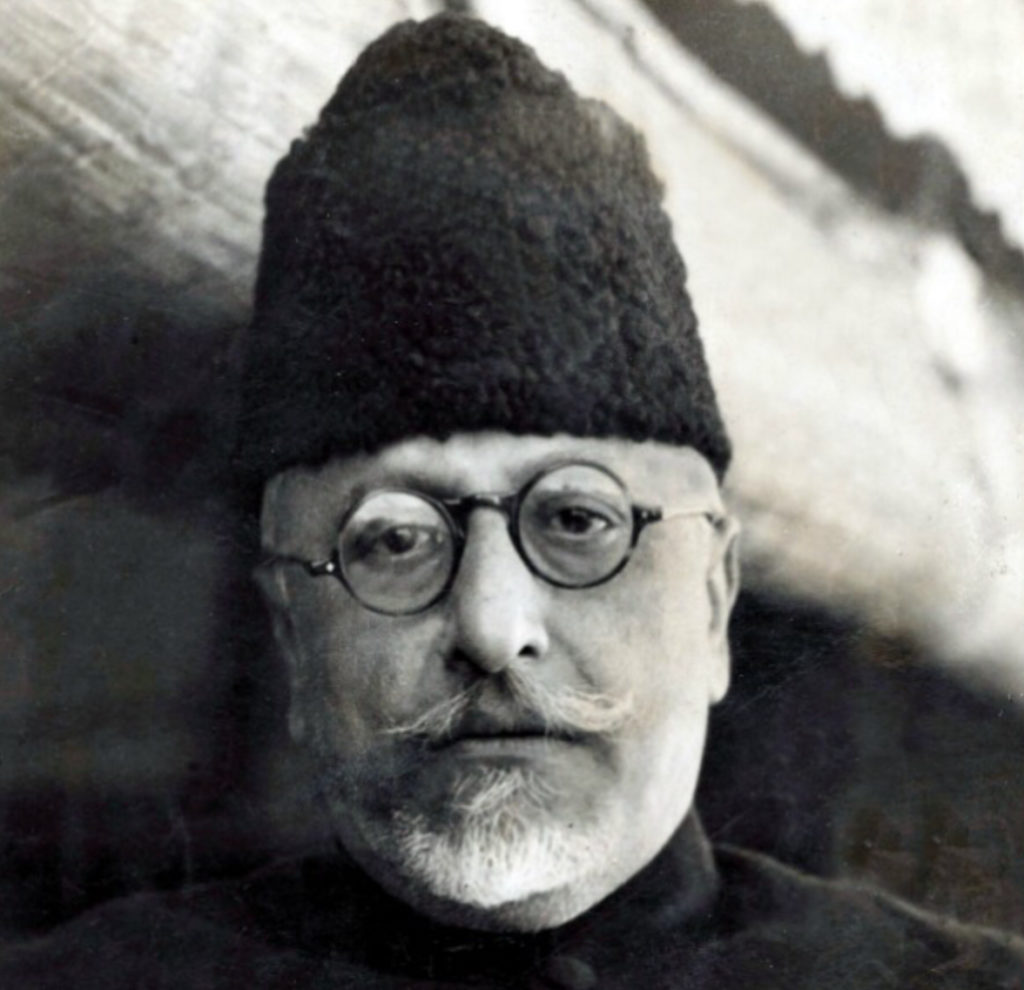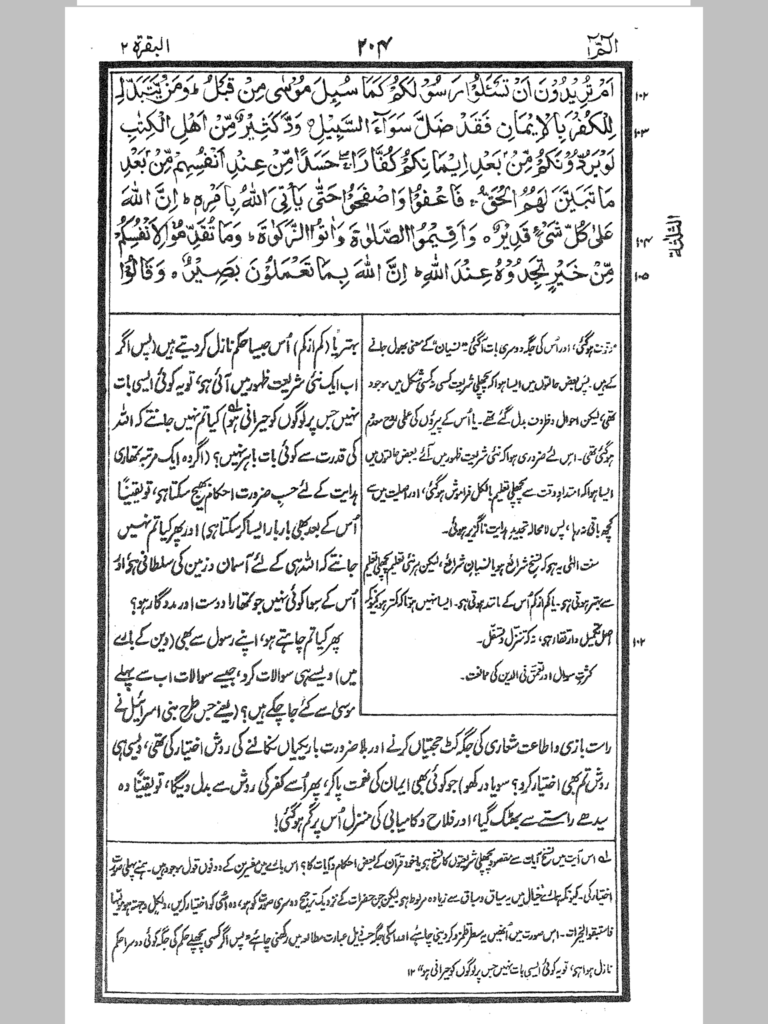This week we look at the Urdu translation by the famous scholar and writer Abul Kalam Azad, who left a lasting impact on the Indian subcontinent through both his journalistic and political careers.
Abul Kalam Azad (d. 1958) was descended from a family that had long served the Mughals in India and that emigrated to Mecca in the mid nineteenth century, where Abul Kalam Azad was born in 1888. His father, Khayr al-Dīn Dihlawī (d. 1908), a Sufi master of the Qādirī and Naqshbandī order, returned to India a decade later, in 1898, with his children and his wife, who was of Arab origin and died shortly after the family settled in Calcutta. Abul Kalam Azad was familiar with both Urdu and Arabic from childhood, due to his parents’ social background, and received religious training at home from his father in accordance with the Dars-i Niẓāmī, the religious education curriculum that was prevalent in India at that time. Khayr al-Dīn Dihlawī placed great emphasis on taqlīd, and was a vehement opponent of reformers such as Shāh Walī Allāh (d. 1762) and the Tarīqa-ye Muḥammadiyya, whom he disparaged as ‘wahhābīs.’ Since his father was a recognized Sufi pir, as Azad describes it, he and his siblings were also revered like idols by his followers.
This childhood environment coupled with his father’s religious views had a lasting impact on Abul Kalam Azad’s career. As he grew older, Abul Kalam Azad became skeptical of his father’s opposition to the religious ideas of Shāh Walī Allāh and modernists such as Sayyid Ahmad Khan. He began to write poems in Urdu under the pen name ‘Azad’ (Free), by which he wanted to indicate, among other things, that he had freed himself from his inherited religious views. As early as the age of thirteen, a resentment against extravagant Sufi worship had developed in the young Abul Kalam Azad. He disliked, for example, the fact that he and his family were venerated and devotees kissed their hands and feet.
This critical attitude toward his environment made Azad, while he was still only in his teens, receptive to new ideas such as those voiced by Sayyid Khan. Within six months, Azad had studied all of Sayyid Khan’s works, and this led him to discard some of the religious views he had previously held. Moreover, Sayyid Khan’s writings enticed him to study modern sciences. This led to a situation where, at the age of 14, Azad had begun to also doubt Sayyid Khan’s views, a state of affairs which, by his own account, brought him to the brink of atheism. Abul Kalam Azad realized, as he describes it himself, that he had broken away from his father’s taqlīd views, but was instead blindly following those held by Sayyid Khan. This religious crisis did not end until 1909, when a mystical experience led him to rethink, and return to religion.
Azad’s formative period was also marked by his journalistic activities. He published his first newspaper at the age of 11. This was followed by others, some of which caused a stir because of their religious stance or political statements. Azad was a very eloquent writer who captivated the intelligentsia with his proficient Urdu style. He used his newspapers to stir up anti-British sentiments and to promote a Hindu-Muslim alliance against the colonial British rulers, and this led the British government to subject him to political persecution.
In 1915, at the age of twenty-seven, Azad announced that he would publish an Urdu translation of the Qurʾan. He saw himself in the tradition of Shāh Walī Allāh, whose influential 1738 Qurʾan translation had aimed to make God’s word accessible to the laity. Azad had the same goal in mind, and he believed that no other translation on the market at the time served this purpose. However, his political involvement proved to be an obstacle to the endeavor, as he was repeatedly imprisoned for his anti-British views and his manuscripts were confiscated. In 1921, his work was again brought to a halt due to another period of imprisonment, and his drafts were seized for a third time. Despite these setbacks, Azad persevered and launched himself out on a new attempt in 1927. Three years later, his efforts bore fruit and resulted in the publication of the first volume of his translation Tarjumān-i Qurʾan, which covered the first six chapters of the holy book and included a comprehensive commentary on Sūrat al-Fātiḥa. Six years later, the second volume followed, comprising the translation of the seventh to the twenty-third suras. In contrast to the first volume, the second volume included, alongside the translation and footnotes, an appendix at the end of each sura which contained a detailed discussion on a range of topics. A revised edition of both volumes appeared in 1945. Thus, if we take 1915 as the starting point of Tarjumān-i Qurʾan, Azad spent almost 30 years preparing his translation.
Azad presented his readers with a translation in which he was able to emphasize his own views in the target text by the clever insertion of additional material in brackets. Although he found fault with Sayyid Ahmad’s modernist views, Azad’s translation also exhibits views that were not held by the mainstream. This is evident, for example, in his treatment of Q 2:106. Yusuf Ali translates the verse as follows: ‘None of Our revelations do We abrogate or cause to be forgotten, but We substitute something better or similar: Knowest thou not that Allah Hath power over all things.‘
Azad, in contrast, rejected abrogation in the sense that Q 2:106 expresses the idea that certain verses abrogate other verses of the Qur’an, and opted for the following choice: ‘(Keep in mind that our law regarding the sending down of revelation is that) in return for what we abrogate from our laws or bring into oblivion, we bring forth something better or (at least) equal. (Now if a new law has appeared, it is nothing that should surprise people). Do they not know that Allah is all-powerful?‘
By adding material in brackets, Azad let his own opinion about abrogation become visible: he believed that abrogation refers to the abrogation of previous religious scriptures and was not applicable to Qurʾanic commandments.
Another characteristic of Azad’s translation is that he presents his views in the appendix of each sura by drawing on historical and biblical sources. For example, his appendix on Sūrah 18 delivers a detailed discussion on Dhū l-Qarnayn, who is mentioned in the text of the sūra, and identifies him with Cyrus.
Azad dealt with a wide range of issues in his translation, which also expressed his political stance. Thus, for example, his opinion that Q 5:51 did not prohibit friendship with Christians and Jews in general is reflected in his treatment of this verse. Pickthall used the following wording in his translation of the beginning of this verse: ‘O ye who believe! Take not the Jews and the Christians for friends.‘
Azad instead translated it as follows: ‘O you who believe, do not take Jews and Christians as friends (who are eager to plot against you).’
In fact, Azad’s work covers a wide range of topics associated with the Qurʾan. Unfortunately, his translation ultimately remained incomplete, and no further volume appeared. This probably had something to do with the fact that Azad thought he had already stated his principles about interpreting the Qur’an in his commentary on Sūrat al-Fātiḥa. However, despite the fact that Azad’s work remained unfinished, his ideas enjoyed great popularity, and because of this his commentary on Surat al-Fātiḥa was re-published in English translation in 1962.
Kamran Ahmad Khan



